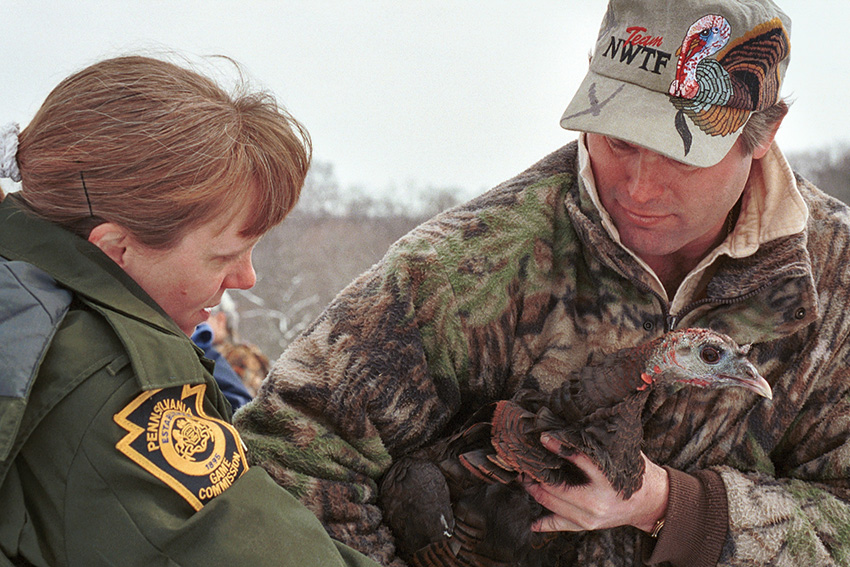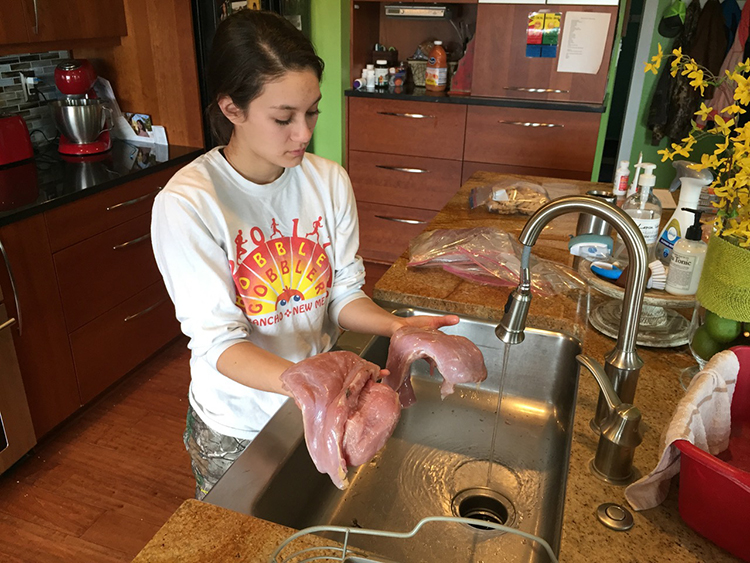Wild Turkey Back On The Thanksgiving Table
Pittman-Robertson Put Wild Turkey Back On The Thanksgiving Table
Editor’s Note: The following is courtesy of the USFWS – Office of Conservation Investment.
Turkey and Thanksgiving have gone hand in hand since colonial times, right? Well, not exactly. The decimation of wildlife followed by the restoration and return to huntable populations is no more evident than it is with wild turkeys. On the front end of that restoration effort was the New York State Department of Environmental Conservation, with funding through Pittman-Robertson.
Research shows how the investment is paying big dividends, and how having wild turkey on the Thanksgiving table is now something we can all celebrate.
From Abundant To Scarce
Despite popular belief, historians aren’t clear whether turkeys were on the table at the first Thanksgiving dinner shared by colonists and the Native Americans in 1621. Wild turkeys were abundant throughout the colonies, and Gov. William Bradford of the Plymouth Colony wrote of the “great store of wild turkeys, of which they took many.” The Wampanoag Tribe brought several deer to the dinner.
When President Abraham Lincoln declared an official Thanksgiving holiday to occur in late November 1863, wild turkeys were extirpated across much of the country. The bird fell victim to unregulated market harvest and the conversion of forested habitat to farmland.
By the late 1800s about 75% of New York was cleared for farmland and turkeys are believed to have been gone from the state since the 1840s. By 1920, wild turkeys were lost from 18 of the 39 states that comprised the bird’s natural range.
Pennsylvania limited turkey hunting in 1873 and New York hired eight “Game Protectors” in 1880 to police the woods and waters. Controlling illegal harvest continued to be a challenge. But as farming declined, abandoned farms returned to brush and eventually woodlands. Habitat was back and around 1948 — a century after they were eliminated from the state — wild turkeys from a small remnant population in Pennsylvania moved into western New York.
Bringing Back The Birds
But there was still a lot of work to do. Those intrepid birds that had wandered into the state found plenty of habitat and were expanding rapidly, but they could only go so far.
Wildlife managers helped them along and in 1952 they began captive rearing to reintroduce the birds into wild, stocking more than 3,000 turkey over the next eight years. But the captive-reared birds were not wily enough to avoid predation and their natural reproduction was low, the endeavor failed.
In 1959, New York Conservation Department (now the Department of Environmental Conservation) Biologist Fred Evans pioneered a method to capture wild turkeys from the booming populations in Allegany State Park. During winter when food was scarce, his team lured birds to corn or other grain then shot a net over the top of them; biologists crated, moved, and released the birds into unoccupied habitats.
According to a NYSDEC history, “A typical release consisted of 8 to 10 females and 4 to 5 males. These birds would form the nucleus of a new flock and generally were all that was necessary to establish a local population.”
Since those early trapping efforts in the late 1950s until the early 1990s, 1,400 turkeys were moved within New York and helped reestablish wild populations. New York also sent more than 300 wild turkeys to the states of Vermont, Massachusetts, New Hampshire, New Jersey, Connecticut, Minnesota, Rhode Island, Delaware and the Province of Ontario, helping to reestablish populations throughout the Northeast.
Similar translocations were carried out by states across the country, often working with partner groups like the National Wild Turkey Federation.
Restoration Returns
Like many other states, New York’s turkey restoration — starting with captive rearing on through the trap and translocation of wild birds — were funded through Pittman-Robertson dollars derived from federal excise taxes on firearms, ammunition and archery equipment. Those funds are matched by the wildlife agencies using hunting license revenues. It’s a private-state-federal partnership paying dividends, and wild turkeys are just one example.
According to Mike Schiavone, game management section head in the NYSDEC Division of Wildlife, “Funding through Pittman-Robertson clearly changed the face of wildlife conservation. Wild turkey restoration in our state is directly connected to the dedicated funding and hunting license fees used to restore and manage this popular game bird.”
Natural resource economics firm Southwick Associates took a closer look at how that investment of Pittman-Robertson funds worked for wild turkeys in New York. The state devoted a total of $2.7 million dollars of Pittman-Robertson funds to turkey restoration from 1953–1985. They spent an annual average of $348,095 and the turkey population rebounded. Ever since the state reopened turkey hunting seasons, the ripple effect to the state’s economy has been growing.
In total, $4.6 billion of economic activity was generated by turkey hunting in New York from 1985–2020. This activity includes direct expenditures by turkey hunters and the additional rounds of spending that occur as hunters’ dollars move through the economy. As an example, turkey hunting supported 555 jobs in New York, from retail stores, local motels and restaurants to businesses statewide.
Turkey hunters spent on average $76.9 million annually over that span, which in turn generated an average of $128.7 million of economic activity each year. More than 10 times the total grant funding from 1953–1985 is generated each year because of turkey hunting.
“It’s not often a relatively small investment creates such a significant business opportunity. Too often people think that conservation comes at the expense of commerce, but we continue to find that this is not the case,” noted Rob Southwick, president of Southwick Associates. “Although many Americans don’t ever see wild turkeys, these birds still have a significant impact on state economies, even in urban areas. And it isn’t just turkeys — Pittman-Robertson has helped restore deer, elk and waterfowl that also have tremendous economic impacts.”
New York is far from alone in wild turkey restoration success via Pittman-Robertson. Between 1973–2023, wild turkey populations soared from 1.1 million to over 6 million turkeys. The reliable and dedicated dollars have funded population assessments, disease management, habitat restoration, harvest evaluations and the purchase of more Wildlife Management Areas.
The change in numbers has been dramatic: in 1973, Connecticut went from an estimated 22 birds to 30,000 in 2023. Similarly, Tennessee’s wild turkey population went from 5,000 to 250,000; California, 8,000 to 400,000 in the span of 50 years of concerted, science-based endeavors with consistent funding.
Pittman-Robertson funds, coming through the firearms and archery industries, serve as the foundation for wildlife conservation efforts — but the restoration successes undertaken in the latter part of the 20th century are now critically important to economies across the country. And it’s a self-perpetuating boon.
Fully restored turkey populations resulted in the rapid growth of turkey hunting in New York and many other states, and with a dramatic increase in the sale of hunting licenses and the development of turkey hunting products — some of which carry that small excise tax that funds conservation.
Bringing Home The ... Turkey
Which brings us back to the beginning of this story and wild turkeys on the Thanksgiving table. These are natural, free-range animals and wild turkey is higher in protein and lower in fat than store-bought turkeys.
According to NYSDEC harvest information, 1,213,654 turkeys have been harvested in spring and fall turkey seasons in New York since 1985—at about 6.5 pounds of edible meat per bird and using the USDA standard serving size of 3.5 ounces; that’s over 36 million servings of wild turkey.
The 2020 harvest in New York was 23,714 birds providing about 705,000 servings, which is equivalent to feeding just under half the population of the Bronx. While New York is consistently on the higher end of total turkey harvest, it’s clear wild turkeys feed many people. Nationally, turkey hunting created 68 million 6 oz. servings of delicious natural food from 2014 to 2019.
And there is that tremendous sense of pride and a connection to your food when you harvest and prepare it yourself. To those of us enjoying a meal of wild turkey, we give thanks to the men and women of conservation that helped bring back these incredible native birds.
For more info on the turkey restoration data, see the fact sheet Wild Turkey Population Restoration, and read the original analysis via Southwick Associates.






